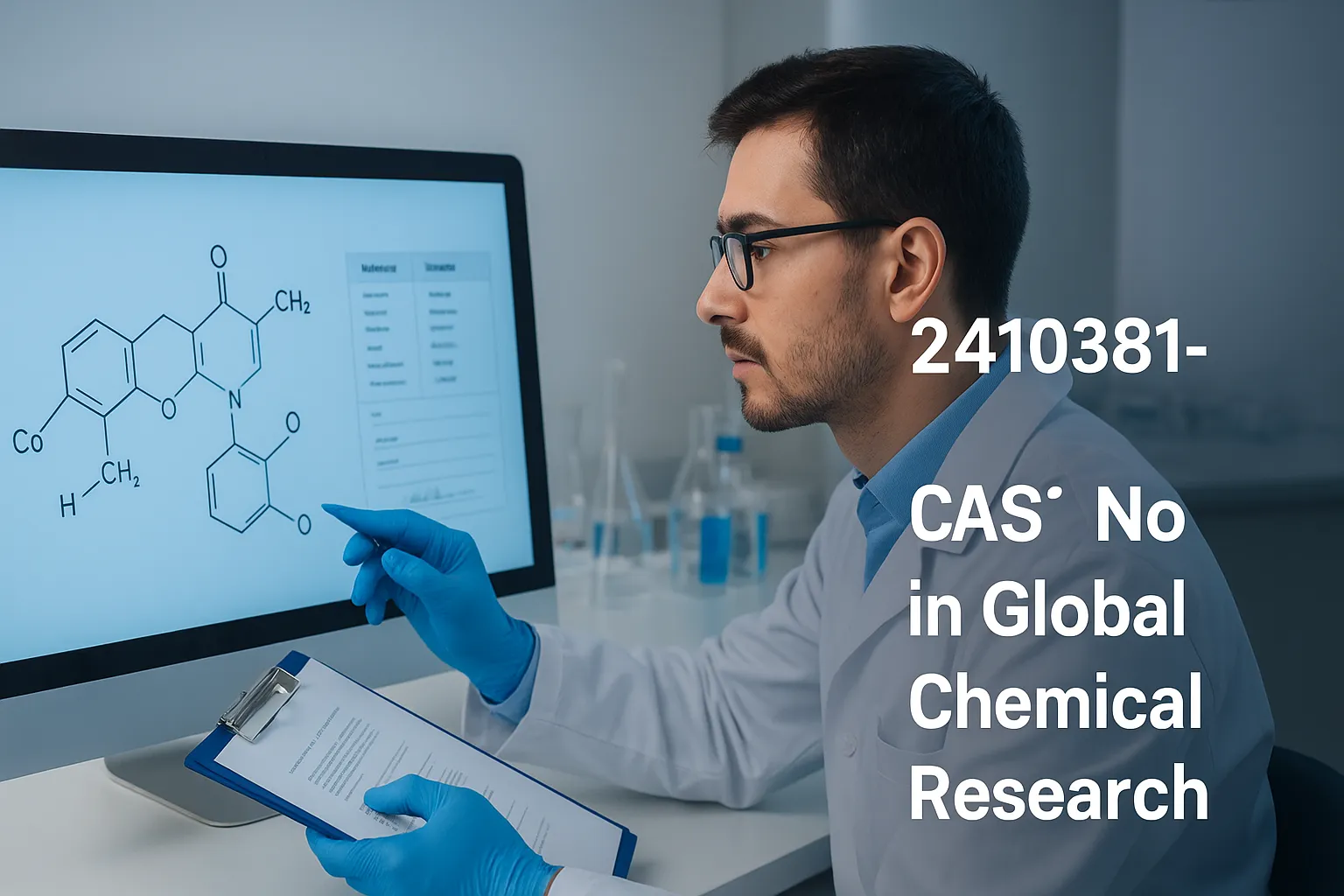In the vast and ever-evolving world of chemical research, accuracy and consistency are the foundation of scientific progress. One small error in identifying a compound can lead to major setbacks in research, safety, and industrial applications. This is why systems like the Chemical Abstracts Service (CAS) registry play such a crucial role. Among the millions of entries within the CAS database, one identifier — 2410381-07-4 CAS No — has emerged as an important reference point across chemical, pharmaceutical, and industrial sectors.
This article explores what 2410381-07-4 CAS No represents, why it is essential in chemical standardization, and how it contributes to global research, safety, and innovation.
What is a CAS Number and Why It Matters
A CAS Number (Chemical Abstracts Service Number) is a unique numerical identifier assigned to every chemical substance described in open scientific literature. Managed by the American Chemical Society’s CAS division, it acts as a global language for chemicals.
Each CAS number is unique — meaning that when you reference 2410381-07-4 CAS No, you are referring to a single, specific chemical substance, not a group or category. This eliminates confusion that often arises from regional or industrial naming variations.
For example, a chemical may have different names in Europe, the United States, or Asia, but its CAS number remains constant. This universal system allows researchers, manufacturers, and regulatory bodies worldwide to refer to the same compound without ambiguity.
2410381-07-4 CAS No: A Key to Data Precision
The main purpose of 2410381-07-4 CAS No is to ensure accuracy in data retrieval and referencing. In today’s digital research environment, countless chemical databases exist — including PubChem, ChemSpider, and NIST Chemistry WebBook — all of which rely on CAS numbers to cross-reference and manage data effectively.
By entering 2410381-07-4 CAS No into these platforms, scientists gain instant access to verified information such as:
- Molecular formula and structure
- Chemical properties and reactivity
- Safety and toxicity data
- Relevant patents, studies, and regulatory records
This streamlined process saves valuable time while ensuring the information being used is correct, consistent, and scientifically validated.
Global Standardization Through 2410381-07-4 CAS No
One of the most significant advantages of the CAS system is global standardization. The 2410381-07-4 CAS No serves as a universal identifier that allows scientists, laboratories, and companies worldwide to speak a common language.
In international research collaborations — especially in pharmaceuticals, materials science, and environmental studies — using a standardized identifier prevents errors that could arise from misinterpretation of local names or translations.
This level of consistency is also vital for maintaining accuracy in supply chains, laboratory testing, and regulatory compliance across multiple countries.
Applications of 2410381-07-4 CAS No in Different Fields
1. Pharmaceutical Development and Biomedical Research
In pharmaceuticals, every molecule matters. The 2410381-07-4 CAS No is used by drug developers to identify and track compounds during drug discovery, testing, and clinical trials.
Researchers use this identifier to check:
- Whether the compound is already patented
- Its previous pharmacological studies
- Toxicology profiles
- Possible drug interactions
This process reduces duplication of research, ensures legal compliance, and accelerates innovation in drug design and testing.
2. Industrial Manufacturing and Chemical Engineering
In chemical production, precision and safety are non-negotiable. Manufacturers use identifiers like 2410381-07-4 CAS No in Material Safety Data Sheets (MSDS) and Safety Data Sheets (SDS) to ensure correct handling, labeling, and transport of substances.
For example:
- Workers rely on CAS numbers to verify safety protocols.
- Regulators use them to check compliance with OSHA and ECHA guidelines.
- Companies track their inventory using CAS numbers to prevent mix-ups or safety breaches.
This ensures a smooth, compliant workflow from production to export.
3. Environmental and Green Chemistry Research
With growing environmental concerns, scientists increasingly rely on CAS identifiers to trace chemical impact on ecosystems. The 2410381-07-4 CAS No enables environmental researchers to locate data on the compound’s toxicity, biodegradability, and environmental persistence.
Through such tracking, researchers can evaluate the compound’s ecological footprint and ensure compliance with sustainability regulations. It also aids in creating safer, eco-friendly alternatives under the framework of green chemistry.
2410381-07-4 CAS No and Regulatory Compliance
Safety and regulation are key in the chemical industry. International organizations such as:
- ECHA (European Chemicals Agency)
- REACH (Registration, Evaluation, Authorisation, and Restriction of Chemicals)
- EPA (Environmental Protection Agency)
— all use CAS numbers as a standard reference for chemicals.
When laboratories or companies list 2410381-07-4 CAS No in compliance reports, it links directly to its full safety and hazard data. This simplifies audits, improves transparency, and helps prevent chemical mismanagement.
Moreover, regulators use CAS numbers to monitor global chemical trade, ensuring restricted or hazardous substances are properly managed according to international laws.
Enhancing Safety with 2410381-07-4 CAS No
Accurate identification of chemicals directly impacts safety in both laboratories and manufacturing facilities. The 2410381-07-4 CAS No is used in Safety Data Sheets (SDS) to outline critical details like:
- Hazard classifications
- First aid measures
- Storage and disposal guidelines
- Exposure limits and personal protective equipment (PPE)
These documents allow professionals to handle chemicals safely and avoid accidents or contamination. Having a unique identifier ensures there’s no confusion about which chemical the safety instructions apply to — a vital aspect of chemical management and risk prevention.
Technological and Research Advancements Supported by 2410381-07-4 CAS No
As modern science moves toward advanced technologies like nanotechnology, synthetic biology, and renewable energy, the importance of accurate chemical identification grows even more.
The 2410381-07-4 CAS No helps scientists in:
- Mapping molecular interactions in AI-driven simulations
- Cross-referencing compounds in machine learning models for drug discovery
- Linking nanomaterials to verified safety and reactivity databases
Such precision accelerates innovation while maintaining strict safety and ethical standards.
Moreover, with industries adopting sustainable chemistry principles, having standardized CAS numbers ensures that eco-friendly materials are properly tracked, tested, and certified for green production.
Data Accuracy and Digital Integration
In an age where digital research and automation dominate laboratories, data integrity has become a central focus. The 2410381-07-4 CAS No ensures that databases, research papers, and patents all refer to the exact same compound — maintaining consistency across multiple digital platforms.
This eliminates the risk of using outdated or incorrect data and helps in building reliable AI-powered research systems that depend on verified chemical datasets.
The Broader Impact of 2410381-07-4 CAS No on Science and Society
While it may seem like just a string of numbers, the 2410381-07-4 CAS No symbolizes something much greater — the global effort to bring precision, transparency, and safety to scientific research.
Through standardization:
- It bridges gaps between researchers worldwide.
- It supports innovation while preventing errors.
- It ensures responsible, safe use of chemical substances.
In a world increasingly driven by cross-border collaboration and rapid technological evolution, such identifiers form the backbone of trust and consistency in the chemical sciences.
Conclusion
The 2410381-07-4 CAS No is far more than an identifier — it’s a cornerstone of chemical accuracy and global collaboration. From laboratories to industries, from environmental monitoring to pharmaceutical breakthroughs, this unique number ensures that scientists and professionals speak a common language of precision.
As chemical research continues to advance, systems like the CAS registry will remain vital in promoting innovation, maintaining safety, and ensuring that every compound — including 2410381-07-4 CAS No — contributes to progress built on reliability and global standardization.



